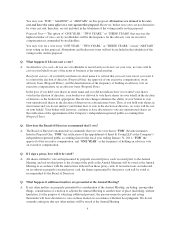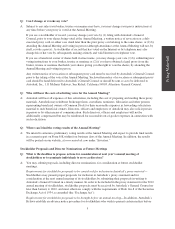Autodesk 2011 Annual Report Download - page 20
Download and view the complete annual report
Please find page 20 of the 2011 Autodesk annual report below. You can navigate through the pages in the report by either clicking on the pages listed below, or by using the keyword search tool below to find specific information within the annual report.short- and long-term focused compensation; meaningful stock ownership guidelines; prohibiting executive
officer’s from “hedging” Autodesk stock; the Compensation Committee’s engagement of its own independent
consultant; a change in control program for our executive officers that requires both a change in control of the
Company and termination of employment (“double trigger”), and does not provide any “gross-ups;” and a strong
risk management program.
We believe that the information we have provided above and within the Executive Compensation section of
this proxy statement demonstrates that our executive compensation program was designed appropriately and is
working to ensure management’s interests are aligned with our stockholders’ interests to support long-term value
creation. Accordingly, we ask our stockholders to vote “FOR” the following resolution at the Annual Meeting:
THE BOARD OF DIRECTORS UNANIMOUSLY RECOMMENDS THAT YOU VOTE “FOR”
THE ADVISORY (NON-BINDING) VOTE APPROVING EXECUTIVE COMPENSATION.
THE AFFIRMATIVE VOTE OF THE HOLDERS OF A MAJORITY OF THE SHARES
PRESENT AND ENTITLED TO VOTE IS NECESSARY FOR APPROVAL.
PROPOSAL FOUR
NON-BINDING VOTE ON THE FREQUENCY OF
THE NON-BINDING VOTE ON EXECUTIVE COMPENSATION
The Dodd-Frank Act also enables our stockholders to indicate, at least once every six years, how frequently
we should seek a non-binding vote on the compensation of our named executive officers, as disclosed pursuant to
the SEC’s compensation disclosure rules, such as Proposal Three beginning on page 10 of this proxy statement.
By voting on this Proposal Four, stockholders may indicate whether they would prefer a non-binding vote on
named executive officer compensation once every one, two, or three years.
After careful consideration, our Board of Directors has determined that a non-binding vote on executive
compensation that occurs annually is the most appropriate alternative for the Company, and therefore our Board
of Directors recommends that you vote for a one-year interval for the non-binding vote on executive
compensation.
We believe that an annual vote will allow our stockholders the ability to frequently communicate to us their
position on our approach to Named Executive Officer compensation through a non-binding executive
compensation vote. An annual vote is aligned with our short term cash programs and the metrics that guide those
programs as well as with our cycle of granting long term equity compensation to our Named Executive Officers.
Our Compensation Committee is responsible for our Named Executive Officer compensation programs and
values our stockholders’ opinions. We understand that our stockholders may have different views as to what is
the best approach for the Company, and we look forward to hearing from our stockholders on this Proposal.
The option of one year, two years or three years that receives the highest number of votes cast by
stockholders will be the frequency for the advisory vote on executive compensation that has been selected by
stockholders. However, because this vote is advisory and not binding on the Company, the Compensation
Committee or our Board of Directors, the Board of Directors may decide that it is in the best interests of our
stockholders and the Company to hold an advisory vote on executive compensation more or less frequently than
the option approved by our stockholders.
THE BOARD OF DIRECTORS UNANIMOUSLY RECOMMENDS AN ANNUAL VOTE AS
THE FREQUENCY WITH WHICH STOCKHOLDERS ARE PROVIDED AN ADVISORY
(NON-BINDING) VOTE ON EXECUTIVE COMPENSATION. THE OPTION RECEIVING
THE GREATEST NUMBER OF VOTES (EVERY ONE, TWO OR THREE YEARS)
WILL BE CONSIDERED THE FREQUENCY SELECTED BY STOCKHOLDERS.
14
























